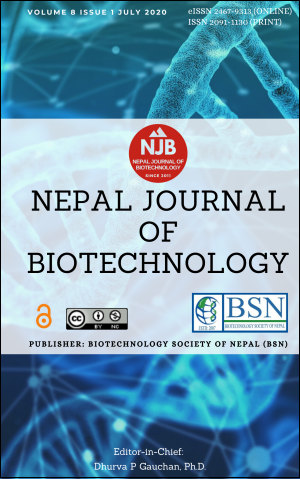Phytochemical Evaluation, Antioxidant and Antimicrobial Activities of Various Extracts from Leaves and Stems of Bryophyllum pinnatum
DOI:
https://doi.org/10.3126/njb.v8i1.30206Keywords:
Bryophyllum pinnatum, Antioxidant activity, Agar well diffusion, Aspergillus niger, polyphenols, Ferric reducing power assayAbstract
Antioxidant and antimicrobial activities of different extracts (methanol and ethyl acetate) of leaf and stem of Bryophyllum pinnatum were studied. The screening for the secondary metabolites was carried out using the standard methods. The antioxidant capacities of the different extracts were assessed using DPPH (2,2-diphenyl-1-picrylhydrazyl) radicals and Ferric reducing antioxidant power (FRAP) while the antimicrobial activity of the extracts obtained were screened against Gram-positive, Gram-negative bacteria and fungi (Staphylococcus aureus, Escherichia coli, Pseudomonas aeruginosa Salmonella spp., Vibrio cholerae, Candida albicans and Aspergillus niger) using Agar well diffusion method. Both extracts obtained from leaf and stem of Bryophyllum pinnatum contained most of the phytochemical compounds tested for. However, anthocyanins and anthraquinone were not detected in leaf extracts while coumarin was absent in stem extracts. Quantification of bioactive compounds showed that both extracts contained the highest concentration of polyphenols (34.49 ±0.47 mg GAE/g and 32.32 ±1.2 mg GAE/g for methanol leaf and stem extracts respectively) while the least concentration was recorded for alkaloids (0.03±0.02 mg/g for methanol stem extract). Results revealed that the extracts showed dose-dependent scavenging of DPPH as well as the ability of the extracts to reduce FeCl3 solution, with methanol extracts exhibiting the highest scavenging and reducing capacity. However the leaves of Bryophyllum pinnatum had greater antioxidant activity than the stem by DPPH and ferric reducing assays, with IC50 values ranging from 3.147µg/ml to 3.80µg/ml for DPPH and 331.9 - 451 µg/ml for FRAP assays. The antimicrobial activity of various solvent extracts of leaf and stem reveal that microorganisms exhibited different sensitivities towards these extracts in a dose-dependent manner. Methanol leaf extract showed no activity against Escherichia coli while Pseudomonas aeruginosa was insensitive to ethyl acetate leaf extract. For stem extracts, Aspergillus niger, Vibrio cholerae and Pseudomonas aeruginosa were resistant to methanol extract while Aspergillus niger, Salmonella spp. and Pseudomonas aeruginosa was resistant towards ethyl acetate stem extract. The results obtained in this study showed that Bryophyllum pinnatum is a reservoir of bioactive compounds and both extracts exhibited significant antimicrobial and antioxidant activity.
Downloads
Downloads
Published
How to Cite
Issue
Section
License
Copyright Notice:
The manuscript submitted to NJB must be an original contribution, not previously published and should not be under consideration for publication elsewhere. When the manuscript is accepted for publication, the authors agree to automatically transfer the copyright of the article to the publisher. It should grant permission to any third party, in advance and in perpetuity, the right to use, reproduce or disseminate your article, according to the NJB copyright and license agreement.
Authors transfer copyright to the publisher as part of a journal publishing agreement but have the rights to: Share their article for Personal Use, Internal Institutional Use and Scholarly Sharing purposes, with the NJB applies the Creative Commons Attribution-NonCommercial CC BY-NC license to all the works we publish after Jun 2020 (Before it was CC BY-NC-ND). Under this license, authors agree to make articles legally available for reuse, without permission or fees, for virtually any non-commercial purpose. Anyone may remix, adapt, and build upon your work non-commercially, and although their new works must also acknowledge you and be non-commercial, they don’t have to license their derivative works on the same terms. More details on CC BY-NC refer to its Licence Deed and Legal Code.






